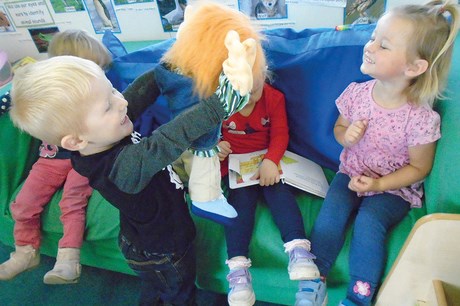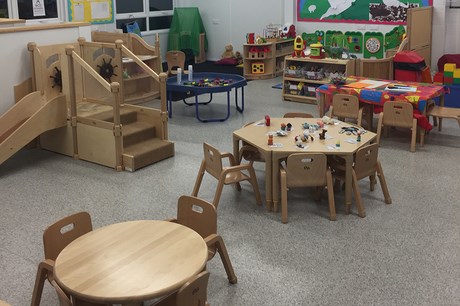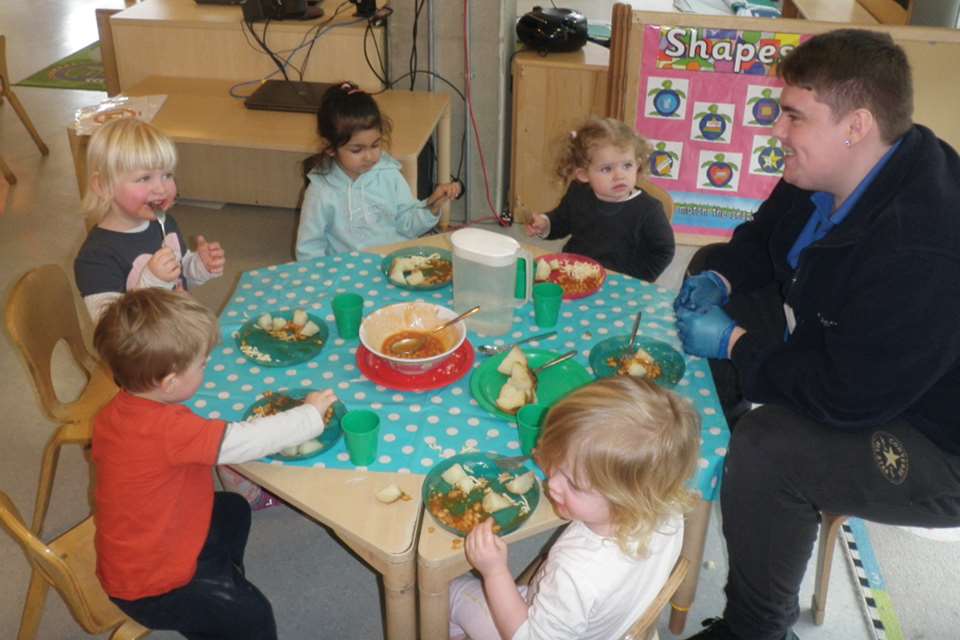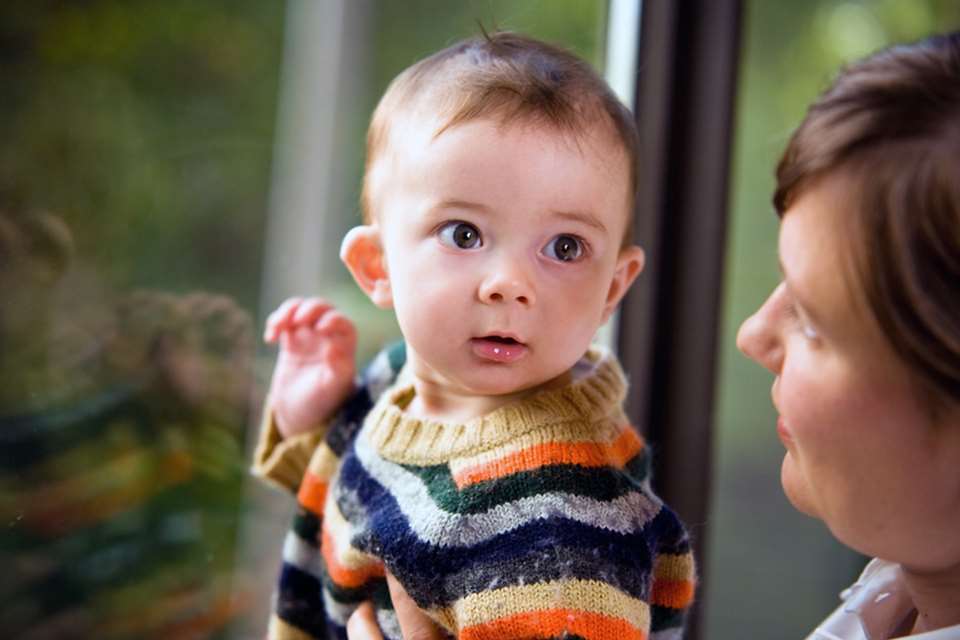Early Years in School: Two-Year-Olds - Small steps
Annette Rawstrone
Monday, January 23, 2017
Take-up is slow, but commitment remains to funded two-year-old places in schools. By Annette Rawstrone

Enabling schools to extend their early years offer to include two-year-olds was met by horror by some in the sector. Four years on and while more than two-thirds of disadvantaged two-year-olds are accessing places, the majority are in private, voluntary and independent settings, with schools remaining hesitant to open their doors to younger children.
The number of funded two-year-olds in maintained nursery schools and nursery classes in primary schools is gradually rising, according to the latest Government figures published in June 2016, but remains low. Private and voluntary providers care for 91 per cent of eligible two-year-olds, compared with just nine per cent in primary schools and nursery schools.
Despite the take-up being slow, a Department for Education spokesperson says it remains committed to offering funded places for two-year-olds in schools: ‘Giving children the best start in life is at the heart of this Government’s agenda, and schools can play an important part in this. We are encouraging them to consider offering early years provision by either running it themselves or in partnership with other providers, such as childminders who can now spend up to half their time working from non-domestic premises. And where they already have an early years offer, we are encouraging schools to consider extending it to include two-year-olds. This is now easier than ever because schools’ provision for two-year-olds is now included in their overall registration.’
The DfE has also made trajectory and capital funding available for small building works to create suitable provision. Schools have been assisted by support from DfE ‘schools demonstrator’ and ‘schools champions’ projects, local authority support (see box, left) and through the Achieving Two Year Olds team.
EXCELLENT WORK
‘It makes absolute sense in areas where traditionally the early learning entitlements are available in schools from three, and where rising threes are already in schools, funded by the schools themselves,’ says James Hempsall, director of consultancy Hempsall’s. ‘There were some concerns about the “schoolification” of early years by some in the sector. However, this does not acknowledge the excellent work that historically and currently happens in schools and on school sites. For us, it is the practice that matters, not the name of the building,’ he explains.
Sue Robb, head of early years at Action for Children, agrees. ‘I’m not interested in the type of provision – whether that’s private, voluntary, independent or school – I’m interested in quality. Quality is top. In my work I’ve seen superb quality provision for two-year-olds across all settings, including schools, and also practice that is less than appropriate across the whole.’
Independent early years consultant Julia Manning-Morton believes the provision of two-year-old places in schools has been done well in those areas where local authorities have required schools to put appropriate provision in place, including a qualified early years teacher to lead the provision. She cites Islington Council as a good example (see box, left).
‘Ensuring the leader of the provision is suitably qualified is key. Otherwise there can be an inappropriate expectation of the way that children play and learn and a lack of understanding of the importance of physical care routines,’ she warns.
‘Worryingly, I do hear practitioners indicate there is a lot of top-down pressure coming from a lack of understanding from managers. When the manager is a teacher trained in the development and learning of older children, there can be the danger of “schoolification” of practice such as sitting at tables, sitting in groups and an inappropriate expectation around children’s play and learning.
‘Also, nursery classes in schools still tend to have a school attitude to parents. It’s not as bad as stopping them at the school gates, but there’s not the same expectation of parents to come in and involve themselves as there is in other settings. When they are working with vulnerable families this has to be high up on the agenda, and they need to have the experience and training to work with needy families.’
SCARED OFF
The patchy take-up of the offer by schools can be attributed to a number of factors. Ms Manning-Morton thinks that while some schools saw the financial advantage of taking two-year-olds, others were scared off by the practicalities, while Mr Hempsall believes it is not through a lack of willingness, rather a need to protect physical space capacity for three- and four-year-olds.
He says it is also down to local market forces which demand how supply changes or remains the same. For parents wanting greater flexibility, the traditional school model, with short days and frequent holidays, does not work.
‘The first thought for schools should be, “Do I need to deliver, or is the local market of PVIs doing a good enough job already?” New school developments can sometimes destabilise established quality settings, and that is not always a good thing,’ he adds.
Looking to the future, Ms Robb cautions that care needs to be taken to ensure quality places for two-year-olds are maintained as providers focus on the 30-hour free offer. Mr Hempsall, whose consultancy is leading on the Government’s new Childcare Works programme to implement the 30-hours policy, says the two-year-old entitlement will continue to be strongly supported.
‘The Government is keen to ensure that take-up for two-year-olds is maintained and continues to grow in areas lower than the national average of around 68 per cent. So, it is business as usual,’ he says. ‘That is a key task of our Childcare Works project.’
CASE STUDIES: SKILLS AND TRAINING
The Northumberland Church of England Academy, Ashington

The Academy started offering funded places for two-year-olds in May 2014. It now cares for 74 two-year-olds across three of its five sites, and works in partnership with an existing children’s centre at another.
‘We were aware that there were a lot of children who were eligible for the two-year-old entitlement and we saw this as an opportunity to support children’s learning and development and build relationships with parents as early as we could,’ explains director of early years Clare Lishman.
She adds, ‘We are based in a community where the loss of heavy industry and the closure of the coal mines has resulted in high unemployment. We were aware that a high percentage of our children have a delay in their speech and language development, with 40 per cent of the current two-year-old cohort requiring targeted support.
‘Because of this, we employ a full-time speech and language therapist who has a team of specialist language assistants who work with the children across the Foundation Stage.’
Another of the Academy’s priorities was to provide a learning environment specifically tailored to the needs of two-year-olds. All senior staff are early years and childcare graduates, with the others trained to at least Level 3. The two-year-old provision is overseen by a teacher with a Master’s degree in early years.
 ‘We strongly believe that our staff are the most important resource,’ says Ms Lishman. ‘Their strong understanding of child development and the early years is crucial, especially as they are working with vulnerable children. Importantly, we all discussed and shared our ideas on good practice for two-year-olds when we were establishing the provision, and this is reflected in our ethos. Through safe and secure relationships, we can make children feel confident, happy and nurtured in an environment where they are given choice but their boundaries are reinforced.’
‘We strongly believe that our staff are the most important resource,’ says Ms Lishman. ‘Their strong understanding of child development and the early years is crucial, especially as they are working with vulnerable children. Importantly, we all discussed and shared our ideas on good practice for two-year-olds when we were establishing the provision, and this is reflected in our ethos. Through safe and secure relationships, we can make children feel confident, happy and nurtured in an environment where they are given choice but their boundaries are reinforced.’
She adds, ‘Building a relationship of trust with parents is also essential. Parents are helped to see the importance of sharing in their child’s learning from the day they register with us, right through their early years at the school.’
A benefit of being part of a school is that robust transition systems are in place for the two-year-olds, which results in the move into nursery being an enjoyable experience for them and their parents. This year, children have started attending the school nursery classes following a full year in the two-year-old provision. Nursery teachers have commented on how quickly the children have settled, and the on-entry data has improved.
WORKING WITH PVI PROVIDERS
Grange Park Primary School, Telford, Shropshire
The primary school is working in close partnership with local private and voluntary childcare providers to provide funded two-year-old places by developing a ‘one-stop shop’ for parents to connect them with available places nearby.
Childcare Hub Around the Park enables local providers to work together to co-ordinate care and wraparound provision, and also increase access to professional training in order to keep quality high. It launched two years ago, supported by DfE funding.
‘We have a 60-place nursery at Grange Park but we felt that there was not the suitable space, staffing ratios or facilities to accommodate two-year-olds, so we are working with local providers to signpost parents to suitable provision,’ says deputy head Nicky Brown. ‘The hub was set up with the aim of addressing the three big issues of places for two-year-olds, flexible provision for parents and maintaining quality provision. We’re working hard to keep two-year-olds on the agenda and not have them squeezed out by the 30-hour offer.’
Places for two-year-olds are in short supply so the hub is working towards increasing the numbers of childminders in the area, including offering training to interested parents. It is hoped that support for local childminders can increase in the future when a new school building is completed.
‘The hub has strengthened relationships with outside providers, with benefits including smoother transitions for children into nursery and Reception,’ says Ms Brown. ‘The information passed on and the value given to it have been good. We’re looking at developing shared learning journeys in the future.’
TAILORED PROVISION
Ardley Hill Academy, Dunstable, Bedfordshire
 The school started offering places for two-year-olds in 2012 and now there are 42 two-year-olds attending morning or afternoon sessions, with 12 receiving funded places. At first, 50 two- to four-year-olds were cared for together until funding from Central Bedfordshire Local Authority enabled the school to build a dedicated two-year-old room, which opened in September 2016.
The school started offering places for two-year-olds in 2012 and now there are 42 two-year-olds attending morning or afternoon sessions, with 12 receiving funded places. At first, 50 two- to four-year-olds were cared for together until funding from Central Bedfordshire Local Authority enabled the school to build a dedicated two-year-old room, which opened in September 2016.
‘Having the children all together had bonuses, such as the older children acting as role models for the younger ones, but their needs are very different and many of the two-year-olds found being in a big room with older children overwhelming,’ says pre-school manager Claire Greaves. ‘Having the separate rooms means that we can structure the day differently for the age groups and offer more age-appropriate activities.’
Staff have attended specific training on working with two-year-olds to support their practice, and the two-year-old room has more focus on sensory and hands-on activities. These are predominantly floor-based so there are fewer tables and increased cushions, cosy spaces and dens. There are nappy-changing facilities as well as toilets.
‘We notice a big difference between two-year-olds and the older children and are very mindful of their age. We do a lot of work around attachment, helping them to feel secure and settled and offer a flexible settling-in period. At the end of the first term, some children were still coming for an hour a day as they built their confidence,’ explains Ms Greaves. ‘The younger children tend to be more anxious and we welcome parents into the setting and encourage them to stay for as long as they like.’
LOCAL AUTHORITY PERSPECTIVE: ISLINGTON
More than £1m additional capital funding was provided by Islington Council to develop or improve spaces for eligible two-year-olds to ensure high-quality provision. Now there are just over 750 part-time places for eligible twos, with more than 40 per cent of these in 13 primary schools; further places are proposed in three more schools.
‘Provision for two-year-olds in schools is separate to nursery provision for three- and four-year-olds, although often there is some shared space indoors and outdoors,’ says head of early years and childcare Penny Kenway. ‘In the schools that developed new provision, the spaces available are offered to eligible two-year-olds only.’
Each school was allocated a link advisory teacher (LAT) and monitoring officer to support in areas such as room design and resources choices, auditing provision and recruitment of high-quality staff – with each school provision led by an EYP/T or a practitioner who holds an early years degree. Practitioners are trained to pay special attention to providing:
• opportunities for the two-year-olds to play on the floor and at a lower level than at tables so they can rest in a squatting position
• space organised so there is a good balance of open and cosy spaces, providing opportunities to rest quietly as well as play actively
• an emphasis on attachment and role of the key person
• opportunities to engage in sensorial and schematic play
• a greater balance of child-initiated, compared with adult-focused, activity
• opportunities to develop gross physical skills.
Analysis of the 2016 EYFS Profile data found that 64.8 per cent of children who took up their funded place during the 2013-14 academic year reached a good level of development, compared with 59.1 per cent of children from similar backgrounds who did not take up the entitlement.
Islington currently enhances the two-year-old funding rate, but Ms Kenway is concerned that, following the consultation on the new early years national funding formula, this will be unable to continue. ‘This may impact on quality, with smaller providers in particular finding it difficult to retain well-qualified staff and the number of two-year-old places available, as providers respond to a rate for three- and four-year-olds in Islington that is higher than the two-year-old rate and the increased number of hours that are now available for them,’ she says.
MORE INFORMATION
• ‘Education provision: children under 5 years of age, January 2016’ by Department for Education (June 2016), www.gov.uk/government/statistics/education-provision-children-under-5-years-of-age-january-2016
• For our 12-part series on the learning and developmental needs of two-year-olds, visit: www.nurseryworld.co.uk/tassoni-two-year-olds
• For our ‘special issue’ on supporting funded two-year-olds, visit: www.nurseryworld.co.uk/two-year-olds
• Julia Manning-Morton’s article ‘The 3Rs’, about two-year-olds in school, along with the rest of the content of our first Early Years in School supplement, is at: www.nurseryworld.co.uk/schools
• Getting it Right for Two Year Olds: A Penny Tassoni Handbook, Hodder Education (2014)
• Two-Year-Olds in Early Years Settings: Journeys of Discovery by Julia Manning-Morton and Maggie Thorp, Open University Press








